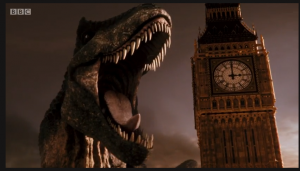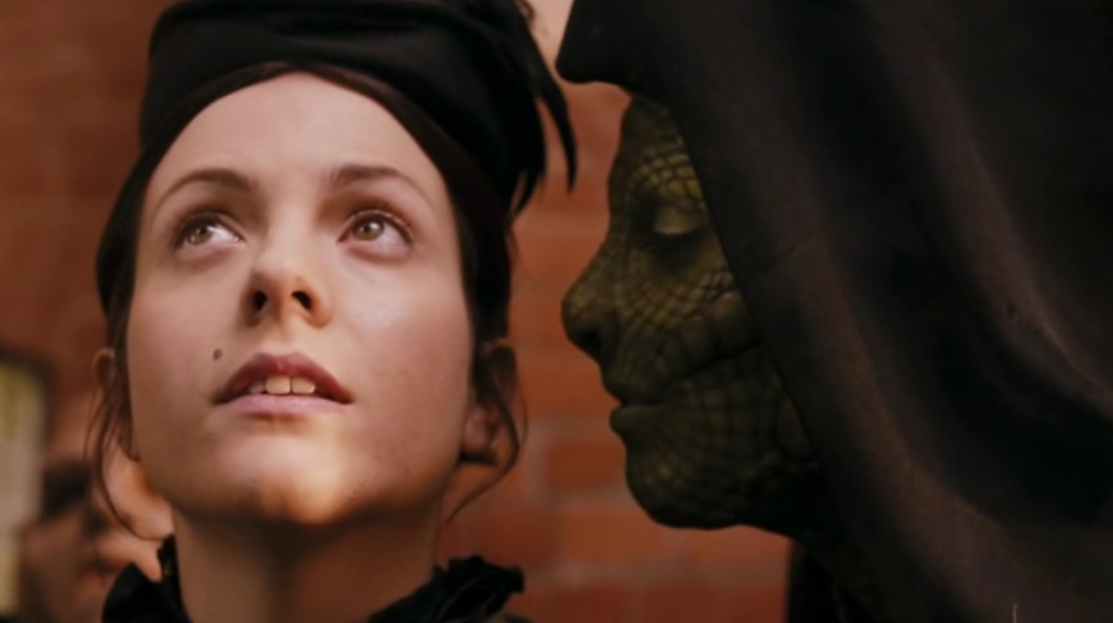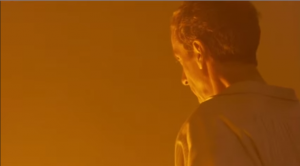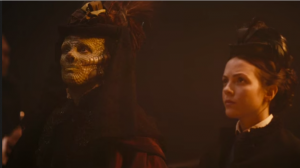a bit belated, but…
The debut of the new Doctor—episode 8.1: Deep Breath—was great,
because…
1. the female Tyrannosaur inadvertently loosed on Victorian London…

CAUTION: Spoilers Ahead
2. Badass lesbian kung fu detectives, one of whom is dino sapiens, in Victorian London.
Madame Vastra, actually part of the Silurian or homo reptilia race, an early Eocene civilization that rose from the dinosaurs and I call dino sapiens, and wife Jenny Flint are awesome leather-clad ninja space detectives who help the police of Victorian London fight crime and kick ass, especially when unusual or otherworldly villainy is afoot.

Apparently awakened from cryo-hibernation by the early construction of the London Underground, explained here, Vastra took to eating Victorian commuters until The Doctor gave her a pep talk. Thereafter, Vastra has mainly limited her diet to the worst of London’s serial killers, child murderers, and the like; she catches them, then “has them for dinner” so to speak.
Madame Vastra and Jenny are totally badass… and after Sontaran nurse Strax was nearly killed alongside the pair while helping The Doctor in the Battle of Demons Run, Strax joined the woman and dino duo in 1888 London. Being an alien potato of non-imposing stature (roughly 5-feet) in appearance and a super aggressive commando programmed to fight for the “glory of the Sontaran Empire” in behavior, Strax doesn’t exactly blend in easily in Victorian London. But his attempts to understand humans from the point of view of a mono-gender world of cloned super soldiers provides a lot of comic relief.
Internet rumors about a Vastra-Jenny-Strax spin-off show are indicative of little more than the three’s huge popularity, but I want to go on record as totally FOR such a TV series! The trio, also known as the Paternoster Gang after their HQ (Vastra’s manse) on Paternoster Row, is a lot of fun, and certainly a big part of why I loved the episode.

3. A scene that confronts Ableism and Agism
This episode is about the new Doctor, The Doctor regenerating into a new body.

During regeneration, disorientation, loss of function and motor control, and sleeping for 24 hours or something are the norm, and there can be regeneration sickness, even regeneration madness as with the Sixth Doctor, who tried to kill his companion Peri during regeneration-related insanity/disorientation. The Tenth Doctor had some regeneration sickness and was revived by a strong cuppa tea.
In this sensitive time of regeneration, The Doctor is… well, disabled doesn’t seem the right word, but certainly vulnerable, not himself, not in his usual fighting shape. The Doctor, the Time Lord who protects all times of Earth’s people, suddenly needs protection. Often, by coincidence or purposefully, alien enemies attack right when The Doctor is least prepared to fight back. This regeneration, The Doctor is disoriented and blacking out when the space detective trio takes him (and Clara) to Paternoster Row, and gives Clara a reality check that is unforgettable.
As the new Doctor is recuperating, Clara, the latest in Doctor Who’s cavalcade of pretty companions, is being weird and whiny about The Doctor regenerating as an older, less flirty, not-Matt-Smith. Madame Vastra reacts by indirectly calling out Clara as a stranger, then dons the veil of srs bzn™ and brings Clara into the sitting room for a serious business sit-down. The exchange that follows is epic, smacking down Clara’s superficiality, agism, ableism. The takeaway: even allies need to check their own biases, reality check. Checketh yourself before you wrecketh yourself.

4. the art direction
Doctor Who keeps getting more beautiful, more well done. This episode didn’t have the type of visual flourish and experimental quick cuts/editing like 6th series (11th Doctor) standout 6.11: The God Complex; it’s visually awesome in its own way. “Deep Breath” has big movie looks, brilliant and cinematic wide shots, and great use of color. Someone behind the camera really understands how color works. It isn’t over-killed thankfully, but different settings have unique color schemes.
The example that sticks out most is the T-Rex post-mortem from a bridge scene, where everything is bathed in orange from the immolated dinosaur. Whatever future technology the villains used to burn the tyrannosaur, it has set the Thames aglow, and in bouncing off the rippling waters, colors everyone in fiery tones.
Like this…

and this…

Fiery rebirth, The Doctor rising from the dino ashes…
5. the villains: Space Age Clockwork Repair Droids
The Clockwork Repair Droids, last seen in the totally awesome Tenth Doctor episode 2.4: The Girl in the Fireplace on the 51st century ship Madame de Pompadour, are a threat to humanity because

they’re programmed to repair/maintain their ship and themselves by any means necessary, up to and including cannibalizing people for parts. While the Clockwork Droids the 10th Doctor faced seemed almost accidentally villainous, repair AI gone wrong after massive damage, these clockwork droids (evidently from the sister ship Marie Antoinette) seem way more psycho and evil as they seek “The Promised Land,” whatever that is.
We don’t know what caused these droids to come to Earth, whether they (and other robo-foes of The Doctor) were called to Earth but didn’t know what century, or if the Clockwork Droids were trying to find what happened to the sister ship Madame de Pompadour‘s droids The Doctor deactivated in 18th century Versailles, accidentally ended up in Mesozoic times and were tampered with or signaled later on, but the unrelenting drive to get to “The Promised Land” is intriguing.
That these droids would dedicate such an inordinate amount of time and energy to extract parts and skin from people for a hot air balloon of human skin instead of robbing or buying a balloon from the local hot air balloon vendor—by this point, 1898, hot air balloons are a long-established and commonplace technology—and that they would go to the trouble of building and running Mancini’s, like “if Hannibal Lecter were to open an Italian restaurant,” fancy cuisine and YOU are the main course… it means that they are so whacked out, perhaps from all the human elements they’ve incorporated, becoming inverted cyborgs or near it, they’re human-obsessed, now almost singlemindedly people scavenging. That is very creepy, and an excellent nemesis to begin the new Doctor with…
they also look really cool.

The idea of inverted cyborgs, androids using so many human replacement parts they’ve ambiguized the distinction between droid and cyborg but are still computers at base-foundation, networked and controlled by one “control node” android, is fascinating.
And it is a good way to debut the new “The Promised Land” mystery arc.
I think that the “Promised Land”/Missy’s virtual world (see Who is Missy?) is a virtual world, digital world, and that the Half-faced Man is uploaded first is significant. The Half-faced Man is the control node for all the Marie Antoinette clockwork droids, but he awakens in psychotic Mary Poppins’ “paradise” and no clockwork droids reactivated as far as we know. This, and that the miniaturized soldier woman in the following episode is obliterated at the atomic level but appears whole and non-miniaturized in Missy’s “heaven,” implies that the consciousness is being uploaded at the moment of death, NOT the body moved. So far, all Missy’s “guests” are from atomized or abandoned dead bodies, and this leads me to believe that the Great Intelligence, or somebody/something with G.I.-esque upload abilities, is uploading people killed in The Doctor’s missions.

6. The Doctor (now Peter Capaldi)
The new Doctor got some great, hilarious lines, like the one about “attack eyebrows” that are so “independently cross” they’re liable to “cede from” the north of his face (a sly topical crack about Scottish independence).
But no one really loves this Doctor. Because you’re not supposed to…not really.
The blog An American View of British Science Fiction shed light on this for me… the new Doctor is more like the First and Sixth Doctors, the hardcore, colder, more alien Time Lords. That, I think, will be a freshener for the series if it doesn’t veer too dreary.
Check out Doctor Who: Deep Breath (2014) | An American View of British Science Fiction for the explanation, how Twelfth Doctor is like the Sixth Doctor and First Doctor. It’s made me want to look into the Classic Doctors.
Nick
Elsewhere on the web:
VoteSaxon07’s SPOILERIFIC REVIEW : Deep Breath is a detailed video review I like, and I agree with the bit about Clara and the Matt Smith cameo – if she’s still too thick to figure out who The Doctor is by the end of the episode and all he did, including rescuing her from vivisection at the hands of the clockwork droids, she should leave, not get a bonus phone-a-friend.
Doctor Who blogging: “Deep Breath” | FlickFilosopher.com – another in-depth review I admired and recommend.
TV Tropes: Deep Breath – I love their dissection of popular tropes Moffat employs in this episode.
Stuart Reviews Stuff: The Girl in the Fireplace Review– on why this Tenth Doctor episode is one of the best episodes “of Anything” EVAR
